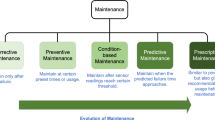Abstract
The fundamental process of predictive maintenance is prognostics and health management, and it is the tool resulting in the development of many algorithms to predict the remaining useful life of industrial equipment. A new data-driven predictive maintenance and an architectural impulse, based on a regularized deep neural network using predictive analytics, are proposed successfully for ring spinning technology. The paradigm shift in computational infrastructures enormously puts pressure on large-scale linear and non-linear automated assembly systems to eliminate and cut down unscheduled downtime and unexpected stoppages. The sensor network designed for the scheduling process comprises different critical components of the same spinning machine frames containing more than thousands of spindles attached to them. We established a genetic algorithm based on multi-sensor performance assessment and prediction procedure for the spinning system. Results show that it operates with a relatively less amount of training data sets but takes advantage of larger volumes of data. This integrated system aims to prognosticate abnormalities, disturbances, and failures by providing condition-based monitoring for each component, which makes it more accurate to locate the defined component failures in the current spinning spindles by using smart agents during the operations through the neural sensing network. A case study has provided to demonstrate the feasibility of the proposed predictive model for highly dynamic, high-speed textile spinning system through real-time data sensing and signal processing via the industrial Internet of Things.
Similar content being viewed by others
References
HERMANN M, PENTEK T, OTTO B. Design principles for industrie 4.0 scenarios [C]//49th Hawaii International Conference on System Sciences (HICSS). Koloa, HI, USA: IEEE, 2016: 3928–3937.
STOCK T, SELIGER G. Opportunities of sustainable manufacturing in industry 4.0 [J]. Procedia CIRP, 2016, 40: 536–541.
THOBEN K D, WIESNER S A, WUEST T. “Industrie 4.0” and smart manufacturing: A review of research issues and application examples [J]. International Journal of Automation Technology, 2017, 11(1): 4–16.
KAGERMANN H, WAHLSTER W, HELBIG J. Recommendations for implementing the strategic initiative INDUSTRIE 4.0 [R]. Frankfurt: acatech - National Academy of Science and Engineering, 2013.
DIEZ-OLIVAN A, DEL SER J, GALAR D, et al. Data fusion and machine learning for industrial prognosis: Trends and perspectives towards Industry 4.0 [J]. Information Fusion, 2019, 50: 92–111.
PARVIN S, HUSSAIN F K, HUSSAIN O K, et al. Multi-cyber framework for availability enhancement of cyber physical systems [J]. Computing, 2013, 95(10/11): 927–948.
MONOSTORI L. Cyber-physical production systems: roots, expectations and R&D challenges [J]. P rocedi a CIRP, 2014, 17: 9–13.
LOFSTRAND M, BACKE B, KYOSTI P, et al. A model for predicting and monitoring industrial system availability [J]. International Journal of Product Development, 2012, 16(2): 140–157.
LEI Y G, LIN J, HE Z J, et al. A review on empirical mode decomposition in fault diagnosis of rotating machinery [J]. Mechanical Systems and Signal Processing, 2013, 35(1/2): 108–126.
GUILLÉN A J, CRESPO A, GÓMEZ J F, et al. A framework for effective management of condition based maintenance programs in the context of industrial development of E-Maintenance strategies [J]. Computers in Industry, 2016, 82: 170–185.
MONOSTORI L, KÁDÁPR B, BAUERNHANSL T, et al. Cyber-physical systems in manufacturing [J]. CIRP Annals, 2016, 65(2): 621–641.
TANTIK E, ANDERL R. Integrated data model and structure for the asset administration shell in Industrie 4.0 [J]. Procedia CIRP, 2017, 60: 86–91.
WU N L, WANG X Y, GE T, et al. Parametric identification and structure searching for underwater vehicle model using symbolic regression [J]. Journal of Marine Science and Technology, 2017, 22(1): 51–60.
JAVANMARD H, AL-WAHHAB KORAEIZADEH A. Optimizing the preventive maintenance scheduling by genetic algorithm based on cost and reliability in National Iranian Drilling Company [J]. Journal of Industrial Engineering International, 2016, 12(4): 509–516.
LI L, ZHANG Y H, YANG C, et al. Hybrid genetic algorithm-based optimization of powertrain and control parameters of plug-in hybrid electric bus [J]. Journal of the Franklin Institute, 2015, 352(3): 776–801.
COMPARE M, MARTINI F, ZIO E. Genetic algorithms for condition-based maintenance optimization under uncertainty [J]. European Journal of Operational Research, 2015, 244(2): 611–623.
LIN T W, WANG C H. A hybrid genetic algorithm to minimize the periodic preventive maintenance cost in a series-parallel system [J]. Journal of Intelligent Manufacturing, 2012, 23(4): 1225–1236.
BOUKTIF S, FIAZ A, OUNI A, et al. Optimal deep learning LSTM model for electric load forecasting using feature selection and genetic algorithm: Comparison with machine learning approaches [J]. Energies, 2018, 11: 1636.
MARS P. Learning algorithms: Theory and applications in signal processing, control and communications [M]. Boca Raton, FL, USA: CRC Press, 2017.
DIKER A, AVCI D, AVCI E, et al. A new technique for ECG signal classification genetic algorithm Wavelet Kernel extreme learning machine [J]. Optik, 2019, 180: 46–55.
Author information
Authors and Affiliations
Corresponding author
Additional information
Foundation item: the National Natural Science Foundation of China (No. 51475301), and the Fundamental Research Funds for the Central Universities of China (No. 2232017A-03)
Rights and permissions
About this article
Cite this article
Farooq, B., Bao, J., Li, J. et al. Data-Driven Predictive Maintenance Approach for Spinning Cyber-Physical Production System. J. Shanghai Jiaotong Univ. (Sci.) 25, 453–462 (2020). https://doi.org/10.1007/s12204-020-2178-z
Received:
Published:
Issue Date:
DOI: https://doi.org/10.1007/s12204-020-2178-z
Keywords
- predictive maintenance
- prognostics and health management
- smart spinning manufacturing
- cyberphysical production system




